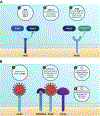Management of chronic pulmonary disease in the time of coronavirus disease 2019
- PMID: 33938475
- PMCID: PMC8097727
- DOI: 10.1097/MOP.0000000000001017
Management of chronic pulmonary disease in the time of coronavirus disease 2019
Abstract
Purpose of review: The purpose of this review is to discuss the most recent data describing the impact of coronavirus disease 2019 (COVID-19) on the pediatric population with chronic pulmonary disease. We specifically focus on children with asthma, cystic fibrosis (CF), and lung transplant recipients.
Recent findings: Children with asthma, CF, and lung transplant recipients do not appear to have an increased risk of morbidity or mortality with COVID-19 infection compared to the general pediatric population. Data does not support the change or withdrawal of any asthma or CF maintenance medications; however, does advocate for the cessation of aerosolized medications whenever possible to minimize transmission risk. It may not be necessary to adjust immunosuppressive therapy when managing COVID-19 in pediatric lung transplant patients. Mechanisms of infection in airway epithelial cells in children may differ from adults, resulting in a milder phenotype.
Summary: Current data about pediatric patients with chronic lung disease infected with severe acute respiratory syndrome coronavirus-2 (SARS-CoV-2) is promising but remains scarce. Additional study is needed to definitively understand the complex interplay of the SARS-CoV-2 virus in the airway of children with chronic lung disease, how it differs from adults, and how best to manage the symptoms of acute infection.
Copyright © 2021 Wolters Kluwer Health, Inc. All rights reserved.
Conflict of interest statement
Conflicts of Interest
Dr. Palla and Dr. Laguna have no conflicts of interest related to this work to report.
Figures




References
-
- Stanton BA, Hampton TH, Ashare A. SARS-CoV-2 (COVID-19) and cystic fibrosis. American journal of physiology Lung cellular and molecular physiology. 2020;319(3):L408–L15. - PMC - PubMed
-
**This paper provides an in-depth description of the SARS-CoV-2 virus and its suspected mechism of action in the CF respiratory epithelium.
-
- Mondejar-Lopez P, Quintana-Gallego E, Giron-Moreno RM, Cortell-Aznar I, Ruiz de Valbuena-Maiz M, Diab-Caceres L, et al. Impact of SARS-CoV-2 infection in patients with cystic fibrosis in Spain: Incidence and results of the national CF-COVID19-Spain survey. Respiratory medicine. 2020;170:106062-. - PMC - PubMed
-
- Centers for Disease Control. COVIDNET COVID-19 laboratory-confirmed hospitalizations 2021. [Available from: https://gis.cdc.gov/grasp/COVIDNet/COVID19_5.html.
-
- Centers for Disease Control. COVID-19 mortality overview 2021. [Available from: https://www.cdc.gov/nchs/covid19/mortality-overview.htm.
Publication types
MeSH terms
Grants and funding
LinkOut - more resources
Full Text Sources
Other Literature Sources
Medical
Research Materials
Miscellaneous

